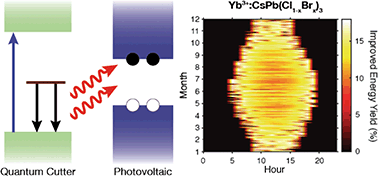Detailed-balance analysis of Yb3+:CsPb(Cl1−xBrx)3 quantum-cutting layers for high-efficiency photovoltaics under real-world conditions†
Abstract
Yb3+-Doped lead-halide perovskites (Yb3+:CsPb(Cl1−xBrx)3) have emerged as unique materials combining strong, tunable broadband absorption with near-infrared photoluminescence quantum yields (PLQYs) approaching 200% at ambient temperature. These remarkable properties make Yb3+:CsPb(Cl1−xBrx)3 an extremely promising candidate for spectral shaping in high-efficiency photovoltaic devices. Previous theoretical assessments of such “downconversion” devices have predicted single-junction efficiencies up to 40%, but have been highly idealized. Real materials like Yb3+:CsPb(Cl1−xBrx)3 have practical limitations such as constrained band-gap and PL energies, non-directional emission, and an excitation-power-dependent PLQY. Hence, it is unclear whether Yb3+:CsPb(Cl1−xBrx)3, or any other non-ideal quantum-cutting material, can indeed boost the efficiencies of real high-performance PV. Here, we examine the thermodynamic, detailed-balance efficiency limit of Yb3+:CsPb(Cl1−xBrx)3 on different existing PV under real-world conditions. Among these, we identify silicon heterojunction technology as very promising for achieving significant performance gains when paired with Yb3+:CsPb(Cl1−xBrx)3, and we predict power-conversion efficiencies of up to 32% for this combination. Surprisingly, PL saturation does not negate the improved device performance. Calculations accounting for actual hourly incident solar photon fluxes show that Yb3+:CsPb(Cl1−xBrx)3 boosts power-conversion efficiencies at all times of day and year in two representative geographic locations. Predicted annual energy yields are comparable to those of tandem perovskite-on-silicon technologies, but without the need for current matching, tracking, or additional electrodes and inverters. In addition, we show that band-gap optimization in real quantum cutters is inherently a function of their PLQY and the ability to capture that PL. These results provide key design rules needed for development of high-efficiency quantum-cutting photovoltaic devices based on Yb3+:CsPb(Cl1−xBrx)3.



 Please wait while we load your content...
Please wait while we load your content...